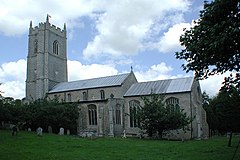Heydon, Norfolk
| Heydon | |
|---|---|
 St Peter and St Paul's church |
|
| Heydon shown within Norfolk | |
| Area | 8.02 km2 (3.10 sq mi) |
| Population |
89 (2001 census) 222 (Including Salle (2011) |
| • Density | 11/km2 (28/sq mi) |
| OS grid reference | TG113273 |
| District | |
| Shire county | |
| Region | |
| Country | England |
| Sovereign state | United Kingdom |
| Post town | NORWICH |
| Postcode district | NR11 |
| Dialling code | 01263 |
| Police | Norfolk |
| Fire | Norfolk |
| Ambulance | East of England |
| EU Parliament | East of England |
89 (2001 census)
Heydon, Norfolk, is an English village in the county of Norfolk and district of Broadland.
Heydon is about 5 miles (8.0 km) north of Reepham, and has no through road, making it isolated except from the south. It consists of a large green, surrounded by picturesque houses and cottages.
The village is listed in the Domesday Book as "High-Down", and was home to a weekly market.
Erasmus Earle, one of the most noted lawyers of his time, was lord of the manor in the early 17th century. The 19th century lord was William Earle Lytton Bulwer (1799–1877), elder brother of the author Edward Bulwer Lytton. The village is still owned by the Bulwer Long family, one of only around a dozen English villages that are entirely privately owned.
Heydon became Norfolk's first conservation area in 1971 and has won its Best Kept Village on two occasions. The village retains an old-fashioned character with no new buildings having been added since the Queen Victoria commemorative well was built in 1887.
The village has a pub, the Earle's Arms, and there is the Elizabethan Heydon Hall, built in 1582 by Henry Dynne and extended in the late 18th and early 19th century.
The late-medieval church of St Peter and St Paul contains some notable wall paintings, rediscovered in 1970.
Heydon is often used in television and film productions. The village was used as the setting for the Anglia Television soap opera Weaver's Green. Films partly shot in the village include The Go Between (1970), Riders (1993), Hitler's Britain (2002), Vanity Fair, The Woman in White, The Moonstone, The Peppermint Pig, and A Cock and Bull Story (2005). A Monty Python's Flying Circus Sketch about village idiots was filmed here.
...
Wikipedia

